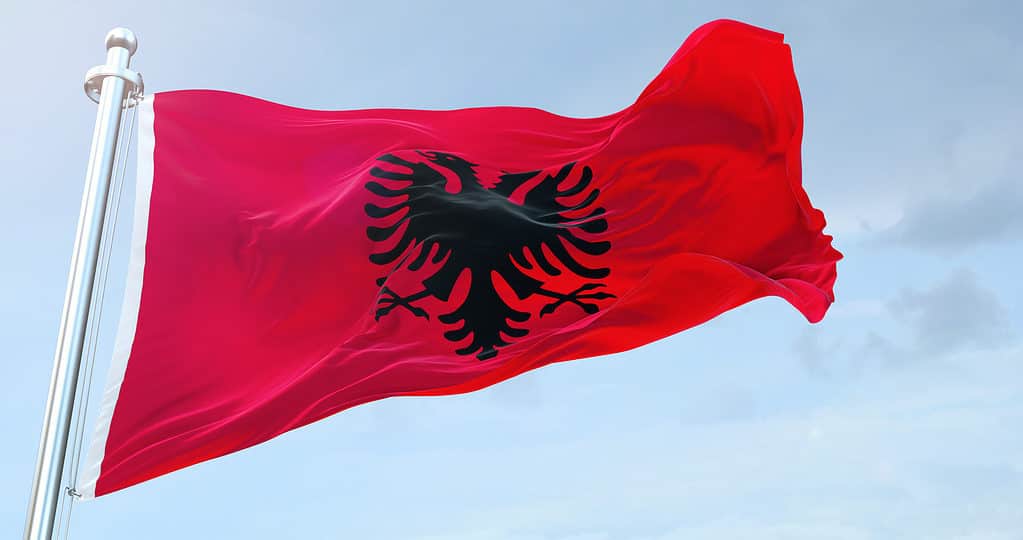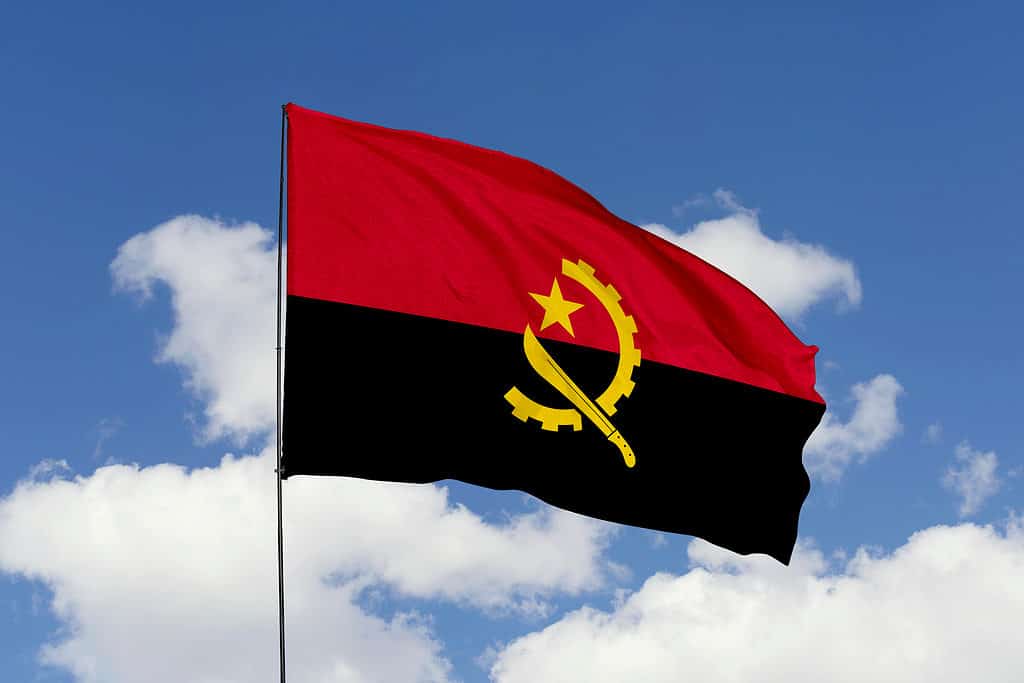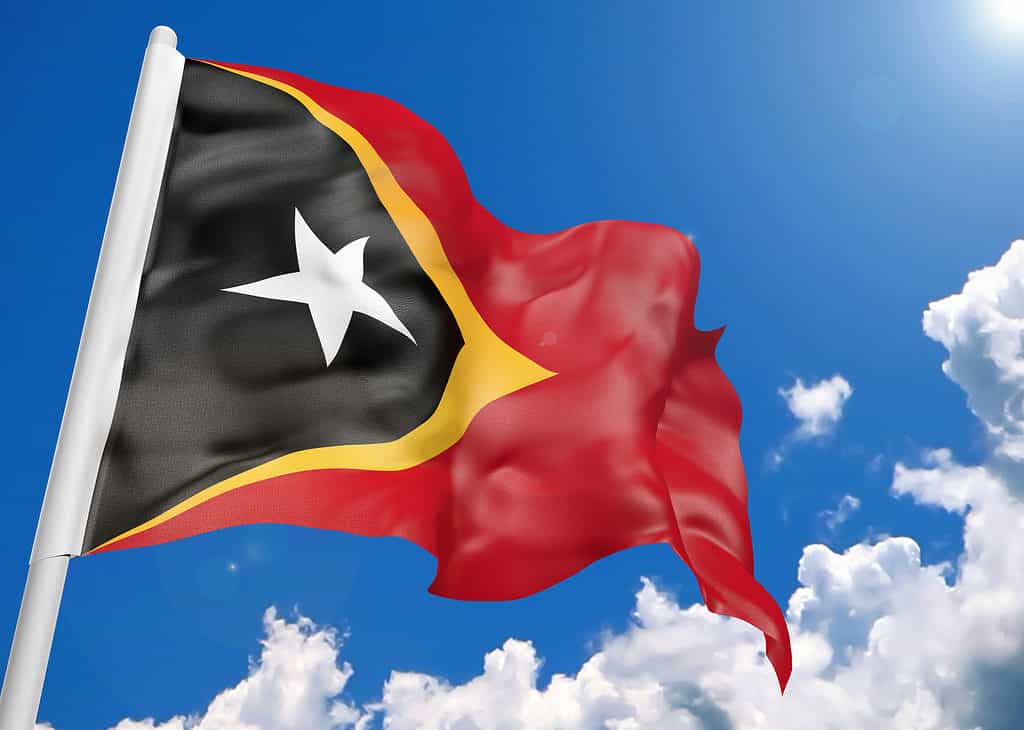We’re going to take a look at five different black-and-red flags flown by countries all across the world today. I bet you didn’t realize that black is the least preferred flag color, despite the fact that red is the most common. Black is rarely seen on national flags, and even less frequently when only one other color is used, like red. The Albanian flag is the only national flag to exclusively include the color combination of black and red!
However, there are a few more national flags that use red and black prominently. In this post, we shall examine these specific flags. These banners may have seals and other multicolored emblems or designs. However, red and black remain the dominant colors in their design. This description applies to five different national flags, each of which we will explore below.
The Flag of Albania

The flag of Albania is red with a two headed black eagle design in the center.
©iStock.com/EA
On November 28, 1443, Albania’s national hero, Prince Skanderbeg (George Kastrioti), defied the Turks by raising his flag over the Kruj fortress. In 1468, after Skanderbeg’s death, the Ottoman Empire regained control of its mountainous realm. He was flying a crimson flag with the Albanian insignia, a black eagle, on it. The Albanian eagle has two heads, much like the eagle of the Byzantine Empire. On November 28, 1912, the Ottoman Empire fell. The red flag with the black double-headed eagle has been the official Albanian flag ever since.
The flag of the Republic of Albania is a red flag with a black double-headed eagle in the middle. The crimson denotes boldness, power, valor, and bloodshed, and the Eagle represents Albania’s independence as a nation.
The Flag of Angola

Angola flag is red and black horizontal bicolor flag with a gold emblem in the center.
©Tatohra/Shutterstock.com
After achieving independence from Portugal on November 11, 1975, the flag of Angola was adopted. The MPLA fought other organizations for control of Angola after Portugal withdrew in November 1975, and on November 11 it declared the People’s Republic of Angola, which was recognized internationally. The new national flag’s center yellow motif and red and black lines made no secret of its ties to the ruling party. The national flag of Angola is comprised of two horizontal bands of red and black, with the Machete and Gear Emblem in gold, which features a five-pointed star within a half-gear wheel that has been slashed by a machete.
According to the Constitution of Angola, the crimson half of the flag represents the blood lost by Angolans during the war for independence, while the black half represents the continent of Africa. The emblem’s star stands for globalization and advancement, the cogwheel represents industrial employees, and the machete stands for agricultural workers. When put together, they look like the former Soviet Union flag’s hammer, sickle, and star.
The Flag of Papua New Guinea

The flag of Papa New Guinea was formerly adopted in July of 1971.
©EA09 Studio/Shutterstock.com
On July 1, 1971, the flag of Papua New Guinea was formally established. A nationwide design competition held in early 1971 ultimately led to the selection of the winning design. Susan Karike, then 15 years old, was the winning designer. A bird-of-paradise flies from the right side of the Papua New Guinean flag, while five stars adorn the left in the shape of the southern cross. The flag features the colors red, yellow, white, and black, with the field of the flag being divided diagonally in half by the colors red and black.
Papua New Guinea’s location in the Southern Hemisphere is confirmed by the presence of the Southern Cross in the night sky. The national emblem, the Bird of Paradise, is a symbol of the country’s consolidation into a single entity. Red and black were formerly the dominant hues in traditional Native American artwork.
The Flag of Timor-Leste

The flag of Timor-Leste was officially adopted in 2002.
©Digiart CT/Shutterstock.com
One of East Timor’s official symbols is the national flag of Timor-Leste. In 2002, East Timor officially adopted its current flag. The flag hasn’t changed since it was first flown nine days after its independence from Portugal in 1975 when Indonesia invaded the country. The United Nations flag was dropped on May 19, 2002, and the flag was flown in the early hours of Independence Day the following day. The flag is red with two conjoined triangles, one black and one yellow, both based on the hoist side and extending to the center; in the center of the black triangle is a white five-pointed star.
In accordance with the East Timorese Constitution:
to symbolize “the vestiges of colonialism in East Timor’s history,” the yellow triangle is used on the East Timorese flag. The flag’s black triangle denotes “the obscurantism that needs to be overcome,” the flag’s red base depicts “the struggle for national liberation,” and the flag’s white star, or “the light that guides,” represents peace.
The Flag of Trinidad And Tobago

flag of Trinidad and Tobago was formally adopted in August of 1962.
©Momcilica/Shutterstock.com
On May 31, 1962, a committee was formed to select a new Trinidad and Tobago flag. They ultimately chose the flag design of a renowned artist by the name of Carlisle Chang. Their choice was accepted on June 28, 1962, and formally adopted on August 31, 1962, after their independence from the UK. It was initially hoisted on Independence Day and is still in use today. Its design is a crimson field with a diagonal, black-edged white band from hoist to fly. It is one of the few national flags to have a diagonal line.
Its diagonal stripes and contrasting colors make it interesting. Black, white, and red symbolized the earth, water, fire, and the nation’s past, present, and future. Black also represented solidarity, strength, and purpose. White symbolized the nation’s two main islands, along with equality, and purity. Red symbolized the sun’s energy, the nation’s life, and the people’s friendliness and courage. The diagonal stripe had no explanation, but it was typical of the Caribbean’s innovative flag designs throughout the next couple of decades.
Up Next:
- White Flag with Red Cross: England Flag History, Meaning, and Symbolism
- Blue Flag with White X: Scotland Flag History, Meaning, and Symbolism
- Black, Red, and Green Flag: The History and Meaning of the Pan-African Flag
The photo featured at the top of this post is © iStock.com/dikobraziy
Thank you for reading! Have some feedback for us? Contact the AZ Animals editorial team.






